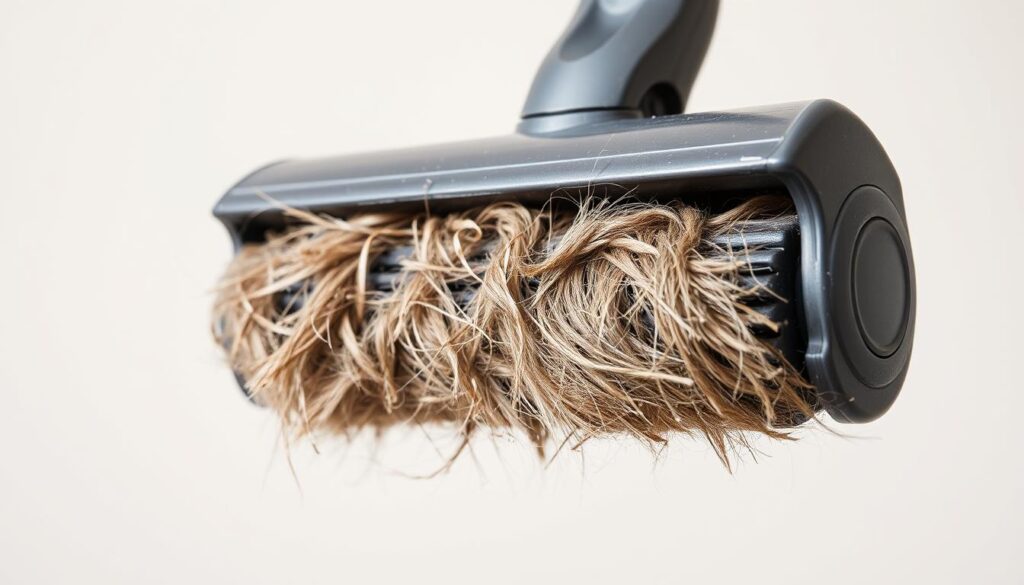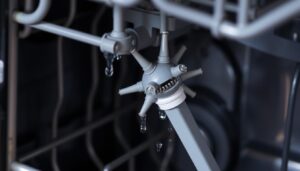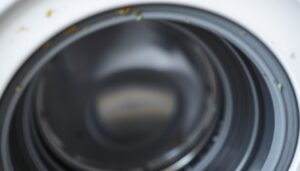Are you struggling with a vacuum that seems to be losing its suction power? A common culprit behind this issue is a jammed roller brush, often clogged with hair and debris.
The roller brush plays a crucial role in lifting dirt and debris from your floor, but when it becomes entangled with hair and dust, its efficiency is significantly reduced.
Regular maintenance of your vacuum‘s brush is essential to maintain optimal suction power and extend its lifespan. In this guide, we will walk you through the process of identifying and clearing the jam to restore your vacuum‘s performance.
Key Takeaways
- Regularly cleaning your vacuum’s roller brush improves its suction power.
- A jammed roller brush can significantly reduce your vacuum’s cleaning efficiency.
- Understanding how to clear a jammed roller brush can extend the lifespan of your vacuum.
- Preventing hair and debris from accumulating on the brush is crucial for maintaining your vacuum.
- Proper maintenance of your vacuum cleaner is key to avoiding costly repairs.
Why Vacuum Roller Brushes Get Jammed
Understanding why your vacuum’s roller brush gets jammed is crucial for maintaining its efficiency. The brush roll is a critical component of your vacuum, responsible for picking up dirt, debris, and hair from your floors.
Common Causes of Roller Brush Jams
Vacuum roller brushes frequently become jammed due to the accumulation of long hair, pet fur, and carpet fibres that wrap around the rotating mechanism rather than being sucked into the dustbin. Additionally, debris such as string, threads, and small fabric pieces can wind tightly around the brush roll, creating stubborn blockages. Dust and dirt build-up around the brush bearings and ends can also cause friction, preventing smooth rotation and eventually leading to complete jamming of the roller.
Signs Your Vacuum Roller Is Jammed
Signs of a jammed vacuum roller include unusual noises, such as grinding or high-pitched whining, reduced suction power, and visible debris wrapped around the brush. Your vacuum may also leave behind dirt and debris rather than collecting it. Many modern vacuum models have safety features that automatically shut off the brush roll when it becomes jammed to prevent motor damage. Regular inspection of your vacuum’s brush can help identify early signs of jamming.
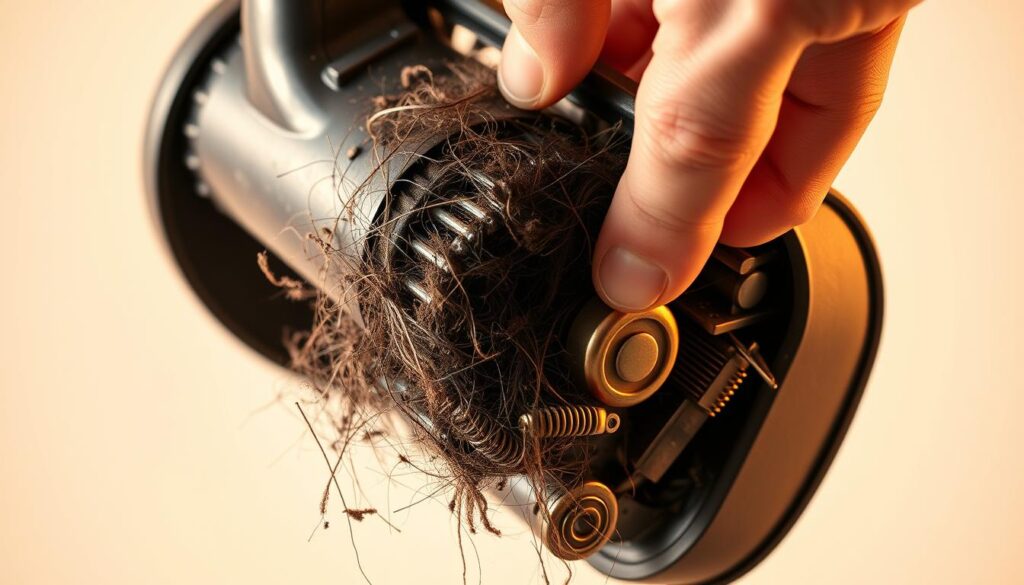
Problems Caused by a Jammed Vacuum Roller
Ignoring a jammed vacuum roller can have significant consequences on the performance and longevity of your vacuum cleaner. A jammed roller brush can lead to various issues that affect not only the cleaning efficiency but also the overall health of your vacuum.
Reduced Suction Power
A jammed vacuum roller brush significantly reduces suction power as it prevents proper airflow through the vacuum, making it difficult to pick up dirt and debris from carpets and floors. This reduction in suction power means your cleaner won’t be able to effectively clean your home.
Strain on the Vacuum Motor
When the roller brush cannot rotate freely, the motor must work harder to maintain suction, causing strain that can lead to overheating and potentially permanent damage to the motor. This additional strain can significantly shorten the lifespan of your vacuum cleaner.
Incomplete Cleaning and Unpleasant Odours
A vacuum with a jammed roller brush cannot effectively agitate carpet fibres to release embedded dirt, resulting in incomplete cleaning and carpets that appear dirty even after vacuuming. Hair and debris trapped in the roller brush can decompose over time, creating unpleasant odours.
| Issue | Description | Impact |
|---|---|---|
| Reduced Suction Power | Prevents proper airflow | Ineffective cleaning |
| Strain on Motor | Causes overheating | Potential motor damage |
| Incomplete Cleaning | Fails to agitate carpet fibres | Dirty carpets |
| Unpleasant Odours | Trapped debris decomposes | Bad smells from vacuum |

Essential Tools to Clear Vacuum-Roller Brush Jam
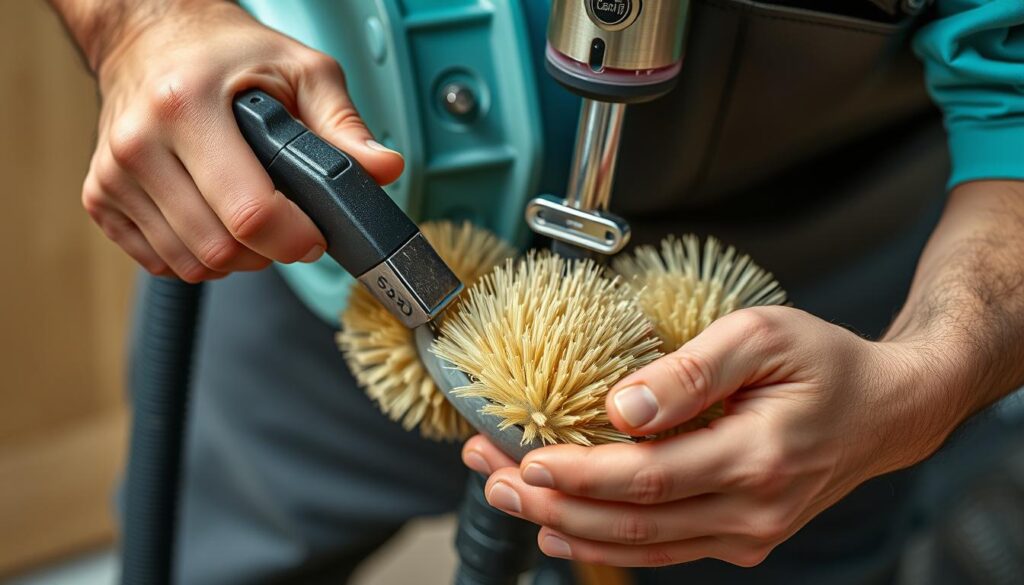
The right equipment is crucial for safely and efficiently clearing a vacuum roller brush jam. Having the correct tools at hand makes the process easier and helps prevent damage to your vacuum cleaner.
Safety Equipment
Before starting, ensure you have the necessary safety gear. Wear protective gloves to shield your hands from dust, debris, and any sharp objects that may be caught in the brush. Always unplug your vacuum cleaner to prevent accidental activation.
Basic Tools for Roller Brush Cleaning
A screwdriver is essential for accessing the roller brush. You’ll need either a Phillips head or flathead, depending on your vacuum model. Use scissors, a safety cutter, or a seam ripper to cut away hair and threads wrapped around the brush roll. A small cleaning brush or an old toothbrush helps remove debris from hard-to-reach areas.
Optional Cleaning Supplies
For a thorough clean, consider using rubbing alcohol or a mild detergent to sanitise the brush and remove built-up grime. Have a cloth or paper towels on hand to wipe down the brush and surrounding areas.
Step-by-Step Guide to Clear Your Vacuum Roller
To keep your vacuum functioning efficiently, it’s essential to learn how to clear the roller brush of hair and debris. Regular maintenance of your vacuum brush ensures that it continues to pick up dirt and dust effectively. In this guide, we will walk you through the steps to clear your vacuum roller and maintain your appliance in good working order.
Preparing Your Vacuum for Cleaning
Before you begin, ensure your vacuum is turned off and unplugged from the power source. This is a crucial safety precaution to prevent any accidental start-ups during the cleaning process. Wear protective gloves to safeguard your hands from dust, debris, and any potential sharp edges. Place your vacuum on a clean, flat surface with good lighting to provide a comfortable working environment.
Accessing and Removing the Roller Brush
Turn your vacuum cleaner upside down and locate the brush cover plate, typically secured with screws or clip mechanisms. Using the appropriate screwdriver, carefully remove the screws holding the cover plate in place, storing them in a small container to prevent loss. Gently lift off the cover to expose the roller brush assembly. Examine how the brush roller is secured in the vacuum housing, noting any side clips, end caps, or belt connections that need to be disengaged.
Removing Hair and Debris from the Roller
Once the roller brush is removed, use scissors or a seam ripper to remove hair and threads wrapped around the brush, being cautious not to damage the bristles or cut the belt if it remains attached. After cutting through the tangled material, use your fingers or tweezers to pull away the loosened hair and debris from around the brush, paying special attention to the ends where hair often becomes tightly wound.
Cleaning the Roller Housing
While the roller brush is removed, take the opportunity to clean the roller housing and surrounding areas, removing any dust or debris that may have accumulated. This ensures that your vacuum continues to function efficiently and effectively.
Reassembling Your Vacuum
Before reassembling, check the roller brush for signs of wear or damage, such as bent axles or worn bristles. When reinstalling the brush roller, ensure it is properly aligned with any notches or grooves in the housing, reattach the belt if necessary, and verify that the brush can rotate freely before securing the cover plate.
| Step | Action | Notes |
|---|---|---|
| 1 | Turn off and unplug the vacuum | Safety precaution |
| 2 | Remove the brush cover plate | Use appropriate screwdriver |
| 3 | Remove hair and debris from the roller | Use scissors or seam ripper |
| 4 | Clean the roller housing | Remove dust and debris |
| 5 | Reassemble the vacuum | Check for wear or damage |
Preventing Future Vacuum Roller Jams
To avoid the hassle of dealing with a jammed vacuum roller, follow these simple tips to prevent future jams. Regular maintenance is key; clean the brush roll at least once a month, or more frequently if you have pets or family members with long hair.
Consider upgrading to a vacuum model with anti-tangle technology or a self-cleaning brush roll. Before vacuuming areas with visible hair accumulation, use a rubber broom or electrostatic sweeper to collect loose hair from the floor.
Regularly inspect your vacuum’s belt for signs of wear or stretching, as a loose belt can cause the brush roll to rotate improperly. By following these tips, you can keep your vacuum cleaner running smoothly and reduce the frequency of cleaning the brush.
